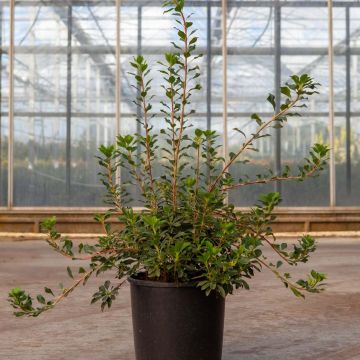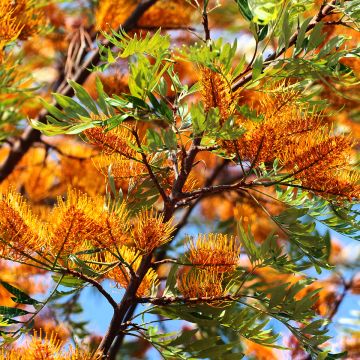

Enkianthus campanulatus Red Bells
Enkianthus campanulatus Red Bells
Enkianthus campanulatus Red Bells
Redvein Enkianthus
This item cannot be shipped to the selected country
Delivery charge from €5.90
More information
Schedule delivery date,
and select date in basket
This plant carries a 24 months recovery warranty
More information
We guarantee the quality of our plants for a full growing cycle, and will replace at our expense any plant that fails to recover under normal climatic and planting conditions.
From €5.90 for pickup delivery and €6.90 for home delivery
Express home delivery from €8.90.

Does this plant fit my garden?
Set up your Plantfit profile →
Description
Enkianthus campanulatus Red Bells is a beautiful variety with deeply red-tinted flowers that are larger than the species. This picturesque bush offers shiny small bell-shaped flowers with red raspberry edges, veins, and stripes on a light pink to white background, in spring. They are in pendant clusters with lovely bright and glossy green foliage at the end of the branches. Before falling, the foliage takes on beautiful yellow to orange autumn colours. The campanulate Enkianthus thrives in partial shade or shade, in the company of rhododendrons and azaleas, in acidic, moist, and humus-rich soil.
Native to Japan and southern China, Enkianthus campanulatus belongs to the family of heathers, just like Pieris, to which it bears some resemblance. It is a deciduous bush of moist and humus-rich undergrowth, perfectly hardy but intolerant of limestone and dry soils.
The 'Red Bells' cultivar mainly stands out from the species for its flowers, which are more colourful and larger. This slow-growing bush will reach an average height of 2.50 m and a width of 1.50 m after many years. Its habit is unique, open and erect, almost columnar, bushy, and composed of regularly layered branches. The original flowering is one of the major assets of this plant. It appears from April to June depending on the climate, for at least 3 weeks. The flowers are borne on short stems at the end of the branches, just below the foliage. The flowers, 1.5 to 2 cm (0.6 to 0.8 in) in diameter and slightly fragrant, are pendant, bell-shaped, and hang from downy peduncles slightly tinted with raspberry, grouped in dense clusters of 12 to 15. They are raspberry pink with lighter stripes, forming a very pretty pattern. The flowering is nectar-rich.
The deciduous foliage consists of small leaves, finely toothed along the edges, 3 to 5 cm (1.2 to 2 in) long and 2 cm (0.8 in) wide. They appear to be arranged in tiers at the ends of the branches, and are bright green from spring to summer. The undersides of the leaves are tinged with red along the veins. The yellow-orange autumn colours are very bright.
Enkianthus campanulatus requires acidic soil and should be planted in ericaceous soil, with Rhododendron, Camellia, Pieris, Kalmia, azaleas, and other heath plants in beautiful combinations in the semi-shaded areas of the garden. It has good hardiness and is not difficult to grow if the conditions are met. Plant it in large shrub beds, in the undergrowth, in a copse, or a slightly wild thicket. Its moderate growth is well suited to small gardens as well as terraces, planted in a large container, always in non-limestone soil.
Report an error about the product description
Enkianthus campanulatus Red Bells in pictures




Plant habit
Flowering
Foliage
Botanical data
Enkianthus
campanulatus
Red Bells
Ericaceae
Redvein Enkianthus
Cultivar or hybrid
Other Enkianthus
Planting and care
Enkianthus campanulatus thrives in semi-shaded positions, sheltered from drying east winds. Plant it in a fresh but well-drained, light, humus-bearing, fertile and acidic soil. This bush does not tolerate limestone or drought. You can protect it in winter by covering the base with straw or dry leaves. This bush does not require pruning. It is disease-resistant.
Planting period
Intended location
Care
-
, onOrder confirmed
Reply from on Promesse de fleurs
Spring-flowering shrubs
Haven't found what you were looking for?
Hardiness is the lowest winter temperature a plant can endure without suffering serious damage or even dying. However, hardiness is affected by location (a sheltered area, such as a patio), protection (winter cover) and soil type (hardiness is improved by well-drained soil).

Photo Sharing Terms & Conditions
In order to encourage gardeners to interact and share their experiences, Promesse de fleurs offers various media enabling content to be uploaded onto its Site - in particular via the ‘Photo sharing’ module.
The User agrees to refrain from:
- Posting any content that is illegal, prejudicial, insulting, racist, inciteful to hatred, revisionist, contrary to public decency, that infringes on privacy or on the privacy rights of third parties, in particular the publicity rights of persons and goods, intellectual property rights, or the right to privacy.
- Submitting content on behalf of a third party;
- Impersonate the identity of a third party and/or publish any personal information about a third party;
In general, the User undertakes to refrain from any unethical behaviour.
All Content (in particular text, comments, files, images, photos, videos, creative works, etc.), which may be subject to property or intellectual property rights, image or other private rights, shall remain the property of the User, subject to the limited rights granted by the terms of the licence granted by Promesse de fleurs as stated below. Users are at liberty to publish or not to publish such Content on the Site, notably via the ‘Photo Sharing’ facility, and accept that this Content shall be made public and freely accessible, notably on the Internet.
Users further acknowledge, undertake to have ,and guarantee that they hold all necessary rights and permissions to publish such material on the Site, in particular with regard to the legislation in force pertaining to any privacy, property, intellectual property, image, or contractual rights, or rights of any other nature. By publishing such Content on the Site, Users acknowledge accepting full liability as publishers of the Content within the meaning of the law, and grant Promesse de fleurs, free of charge, an inclusive, worldwide licence for the said Content for the entire duration of its publication, including all reproduction, representation, up/downloading, displaying, performing, transmission, and storage rights.
Users also grant permission for their name to be linked to the Content and accept that this link may not always be made available.
By engaging in posting material, Users consent to their Content becoming automatically accessible on the Internet, in particular on other sites and/or blogs and/or web pages of the Promesse de fleurs site, including in particular social pages and the Promesse de fleurs catalogue.
Users may secure the removal of entrusted content free of charge by issuing a simple request via our contact form.
The flowering period indicated on our website applies to countries and regions located in USDA zone 8 (France, the United Kingdom, Ireland, the Netherlands, etc.)
It will vary according to where you live:
- In zones 9 to 10 (Italy, Spain, Greece, etc.), flowering will occur about 2 to 4 weeks earlier.
- In zones 6 to 7 (Germany, Poland, Slovenia, and lower mountainous regions), flowering will be delayed by 2 to 3 weeks.
- In zone 5 (Central Europe, Scandinavia), blooming will be delayed by 3 to 5 weeks.
In temperate climates, pruning of spring-flowering shrubs (forsythia, spireas, etc.) should be done just after flowering.
Pruning of summer-flowering shrubs (Indian Lilac, Perovskia, etc.) can be done in winter or spring.
In cold regions as well as with frost-sensitive plants, avoid pruning too early when severe frosts may still occur.
The planting period indicated on our website applies to countries and regions located in USDA zone 8 (France, United Kingdom, Ireland, Netherlands).
It will vary according to where you live:
- In Mediterranean zones (Marseille, Madrid, Milan, etc.), autumn and winter are the best planting periods.
- In continental zones (Strasbourg, Munich, Vienna, etc.), delay planting by 2 to 3 weeks in spring and bring it forward by 2 to 4 weeks in autumn.
- In mountainous regions (the Alps, Pyrenees, Carpathians, etc.), it is best to plant in late spring (May-June) or late summer (August-September).
The harvesting period indicated on our website applies to countries and regions in USDA zone 8 (France, England, Ireland, the Netherlands).
In colder areas (Scandinavia, Poland, Austria...) fruit and vegetable harvests are likely to be delayed by 3-4 weeks.
In warmer areas (Italy, Spain, Greece, etc.), harvesting will probably take place earlier, depending on weather conditions.
The sowing periods indicated on our website apply to countries and regions within USDA Zone 8 (France, UK, Ireland, Netherlands).
In colder areas (Scandinavia, Poland, Austria...), delay any outdoor sowing by 3-4 weeks, or sow under glass.
In warmer climes (Italy, Spain, Greece, etc.), bring outdoor sowing forward by a few weeks.















































